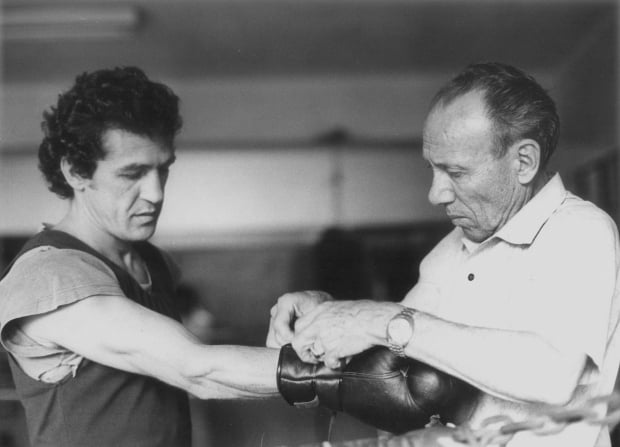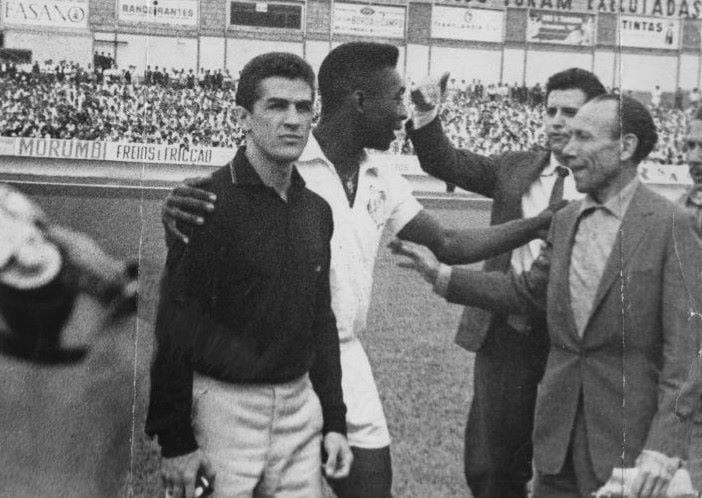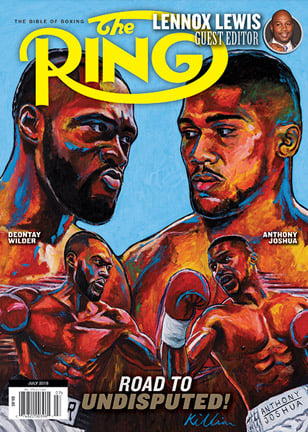Best I Faced: Eder Jofre

Eder Jofre is widely recognized as one of the best South American fighters in history. The diminutive Brazilian became the soccer-crazed country’s first boxing world champion when he won the bantamweight title in November 1960. He later added to his legend by winning the WBC featherweight crown in 1973.
Jofre grew up the son of an Argentine father and Italian mother; his childhood was tough.
“My childhood was in a extremely poor neighborhood,” Jofre told THE RING through Patrick Nascimento. “The best games were in the streets, playing ball, playing with gloves, rehearsing what would be my future profession. At this time I dreamed of being like Captain Marvel and Superman. I think the inspiration was good.”
At that time boxing wasn’t well known in Brazil. Soccer was the national obsession.
“My father came was from Argentina (and) was a lover of the noble art and had already practiced as an amateur,” he explained. “When he came to live in Brazil and met the family of my mother, who loved boxing, there was a lot of interest and one of the greatest dynasties of the sport in the world began. Many cousins, uncles and others boxed; it became the official sport of my family.”
With an upbringing like that, how could Jofre’s future have been different? He had a good amateur career that culminated in representing Brazil at the 1956 Olympics in Melbourne, Australia.
Unfortunately for Jofre, he lost at the quarterfinal stage and didn’t return home with a medal.
“The Melbourne Olympics were a great learning experience for the rest of my career,” he said, “especially the way I prepared myself in my workouts. Before the Games, due to a lack of sparring partners in my weight, I trained with bigger boxers and I was hurt in one of the workouts. That affected my performance. It hurts me that I lost to Claudio Barrientos; in a rematch (as a professional). I knocked him out in eight rounds.”
In early 1957, Jofre made the move to the pros. Over the course of the next four years, he went 29-0-3. In his 33rd fight, he met old rival Ernesto Miranda – the two had fought two draws in 1957 – this time “Galo Do Ouro” (“Golden Rooster”) won by 15-round unanimous decision to claim the South American title.
By the summer of 1960, Jofre met Jose Medel in an eliminator for the NBA 118-pound title. It was also his American debut and he impressed with a 10-round knockout. His reputation as a fearsome puncher continued to grow.
He calls it his greatest and most difficult fight: “He was a very good technical boxer, great athlete. Honestly if it wasn’t for my father in my corner, that night might have been different. The guidance he gave me (was) critical to my success.”
While soccer player Pele was idolized in Brazil, a household name the world over, Jofre was less known but much loved in his homeland. The two remain friends to this day.

Eder Jofre and soccer legend Pele
Three months later, Jofre knocked Eloy Sanchez out, in six rounds, for the title vacated by Joe Becerra. After two defenses, his team coaxed the unbeaten Johnny Caldwell to make the trip to Sao Paulo to defend his world title in early-1962.
Jofre made the most of the opportunity and erased any doubt as to whom the No. 1 bantamweight in the world was, emphatically stopping the Northern Irishman in 10 rounds.
After making his maiden defense in California, he returned home to see off Medel in a rematch. He traveled to the backyards of the talented trio, Katsutoshi Aoki, in Japan, Johnny Jamito, in the Philippines, and Bernardo Caraballo, in Colombia, and stopped each of them.
In May ‘65, Jofre took to the road again, returning to the “Land of the Rising Sun,” this time to face former flyweight world champion Fighting Harada. The Japanese challenger eked out a split decision that, to this day, Jofre contests.
“Honestly I won that fight, and won well,” he said defiantly. “I’m not saying that; everyone except the judges saw who won the fight. Japanese people on the streets cheered me (as) the winner. That attitude helped me contain the pain of losing my title and unbeaten record.
“I had great support from my family and all the Brazilian people. The fight was hard, at first, because Harada was very fast and had a lot of energy but he also held me a lot. Because of the height difference, I took many headbutts. The judges didn’t take that into account; that hurt me a lot. What I like to remember is how well the people in Japan treated me with sympathy, great affection and friendship. I have great regard for the Japanese people.”
The two met a year later, again in Japan. Harada repeated his win, this time by unanimous decision. It prompted Jofre to retire from professional boxing.
“After I lost the rematch to Harada, I lost the incentive to keep fighting,” he said. “It was a very difficult stage in my life, with many doubts about the future: What to do?
Although boxing was in his soul, Jofre stepped away from the sport and helped his aunt, who owned a circus. He fought in the circus and was very popular, traveling to various cities in Brazil performing.
However a friend of Jofre’s, whom was also the President of the Paulista Federation Pugilismo, Newton Campos, and his father helped motivate him to return to boxing, this time as a featherweight after a three-year absence.
He won 14 consecutive bouts in a near-four-year spell before he enticed Jose Legra to come to Brazil to face him, in May of 1973. “Jofrinho” (“Lil’ Jofre”) relieved the Cuban of his WBC 126-pound title in a close fight, by majority decision.
“Becoming world champion in two weight classes at 37 years old was magical for me,” he said proudly. “It was proof that I still had something left. I won all 25 fights at featherweight. The first world title was for the Brazilian people; the second was for me.”
Later that year, Jofre knocked out future Hall-of-Famer Vicente Saldivar in four rounds in his lone title defense. He was stripped of his title in June ‘74 but remained active, fighting seven more times – all victories.
He retired for good in the fall of 1976, exiting with a supremely impressive ledger of 72-2-4, with 50 knockouts.
During his Hall of Fame career – Jofre was inducted in 1992 – he fought everyone he wanted to…with one exception.
“In my career I never had an easy fight. My record was built fighting class boxers and always well-ranked, former world champions, continental champions, among others,” he said before playfully quipping. “In my time I was pleased to fight the best. If you could travel back in time and change (weight) category, who knows? Maybe against Muhammad Ali (laughs). Dreaming is always good.”
Jofre, now 82, was married to Maria Aparecida for 53 years, until her passing in 2013. He has two children, Marcel 52, and Andrea 47, and six grandchildren.
Since retiring in 1976, Jofre has led an active life.
“My book came out in the ’80s,” he said. “I began a political career and, in 1982, I ran for alderman in São Paulo. I stayed until 2000. From 2000 to date, I have been involved in some advertising and a great project that is the realization of a feature film about my life, to be released later this year.”
Jofre agreed to speak about the best fighters he fought in 10 categories.
BEST JAB
José Legrá: He was tall for the (weight) category. (He) measured about 174 centimeters (5-foot-8) and had long arms. They said he was the mini-Muhammad Ali (or “Pocket Cassius Clay”).
BEST DEFENSE
Ernesto Miranda: I fought four times against him, (the) Argentine with excellent technique and tremendous energy. (I had) great difficulty getting through his defense. There were two draws and two wins.
BEST CHIN
Tony Jumao-As: As it was a featherweight, with technical limitations, but it felt like I was hitting a stone.
FASTEST HANDS
Fighting Harada: (He) had a lot of velocity in his arms, reaching to hit me recklessly several times. It was a style of his own that hindered the opponent when he tried to hit him.
FASTEST FEET
Legrá: He moved around the ring with excellent footwork, trying to use his long arms to force his opponent to struggle.
SMARTEST
Harada: I consider him the fastest as well.
STRONGEST
Danny Kid: He took a lot; his resistance was incredible. I knocked him down three times during the fight and I won on points.
BEST PUNCHER
José Medel: He might not have the biggest punch but he was accurate, with a lot of technique and precision. That made him a very dangerous opponent.
BEST SKILLS
Vicente Saldivar: But he had no time to show his skills. My father was sick; I had to try to win quickly. My father had cancer and was too weak. After the match, he had to undergo medical care. It was kill or die! I survived!
BEST OVERALL
Medel: The most complete fighter I fought. He provided me with the necessary security to become champion of the world against Eloy Sanchez. After I won the Medel fight, in 1960, I felt unbeatable.
Brazilian boxing agent Patrick Nascimento helped coordinate and translate this feature. THE RING appreciates his assistance.
Questions and/or comments can be sent to Anson at [email protected] and you can follow him on Twitter @AnsonWainwright.
Struggling to locate a copy of THE RING Magazine? Try here or
Subscribe
You can order the current issue, which is on newsstands, or back issues from our subscribe page.















